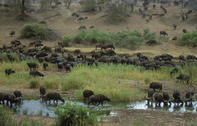Bulk Grazers

Buffalo are bulk grazers taking large quantities of long grass while they continuously move through an area. A herd of feeding buffalo sound much like a gentle bushfire crackling through dry grass. They feed unselectively (despite being ruminants) selecting quantity over quality to sustain their large bodies.
In the process of feeding, buffalo trample pastures and reduce long, less palatable grasslands to a height and quality (when it re-shoots) more easily utilized by zebra and subsequently wildebeest. This is known as grazing succession. Buffalo have a wide row of incisor teeth which they use in conjunction with their tongues to crop grass swiftly while they move.
They lack the movable lips of more selective feeders. Because of the vast quantity of coarse material eaten, buffalo are dependent on regular access to drinking water. They drink daily sometimes even twice a day during drier times. The approach of a large herd of buffalo to a waterhole in winter is a noisy and spectacular affair.
They move resolutely in the direction of a waterhole during the late afternoon and the approach of the columns of fast-moving animals can be detected some distance off by the presence of an advancing cloud of dust. The herd will arrive and submerge belly deep in the water to drink. They may consume up to 35 litres of water at a time, drinking this up in mere minutes.